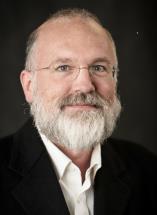Gregory Boebinger, PhD

Gregory S. Boebinger, PhD, is the director of the National High Magnetic Field Laboratory in Tallahassee, Florida and a professor of physics at Florida State University. The National High Magnetic Field Laboratory is a three-campus user facility, home to six user programs in physics, chemistry and biology, and a world leader in the study of high magnetic fields.
In 1981 as an undergrad, Greg earned three degrees – in physics, philosophy and electrical engineering – from Purdue University. With a Churchill Scholarship, he traveled to the Cambridge University for one year of research under Professor Sir Richard Friend, studying the temperature dependent structural changes in one-dimensional organic superconductors. His 1986 doctorate in physics came from the Massachusetts Institute of Technology. There, he held Compton and Hertz Foundation fellowships. His work involved experiments with high-powered magnets at the MIT Francis Bitter Magnet Laboratory, and it was there he became a graduate assistant for two scientists who would later win the 1998 Nobel Prize in Physics: Horst Ludwig Störmer, then of Bell Laboratories, and Daniel Tsui, then a professor at Princeton University. His thesis research utilized high magnetic fields and ultra-low temperatures to study fractional quantum Hall effect. Afterwards, he spent a year as a NATO Postdoctoral Fellow in Paris at the Ecole Normale Supérieure studying other quantum behaviors of electrons in quantum wells.
In 1987, Boebinger joined the research staff at Bell Laboratories and established a unique pulsed magnetic field facility for physics research on semiconductors, f-electron compounds and superconductors in magnetic fields up to 60 tesla. For this research, he was named a fellow of the American Physical Society in 1996.
In 1998, Boebinger became head of the Pulsed Field Facility at Los Alamos National Laboratory, one of the three campuses of the National High Magnetic Field Laboratory. There he continued his research on high-temperature superconductors, using the intense pulsed magnetic fields to suppress superconductivity. He also did a stint as deputy director for Science Programs in the Division of Material Science and Technology.
In 2004, Dr. Boebinger moved to Florida State University to become director of the Magnet Lab, with responsibility for the lab’s programs at all three campuses: Florida State University, Los Alamos National Laboratory, and the University of Florida. The MagLab is the world leading magnet laboratory, developing and operating high magnetic field facilities that more than 1700 scientists use annually for research in physics, biology, bioengineering, chemistry, geochemistry, biochemistry, materials science, and engineering. More information can be found on the MagLab’s website: nationalmaglab.org.
Gregory is keenly interested in communicating science to the general public. His outreach has included commencement addresses, public lectures and demonstrations on levitation at Aspen’s Wheeler Opera House, at Bell Laboratories, Los Alamos, and the Getty Museum. He has appeared on the History Channel and Discovery Channel and has written articles for Physics Today and Scientific American. He has a special interest in the historical development of materials research and the interplay of the Arts and Sciences. In 2017, Greg was named a fellow of the American Association for the Advancement of Science and, in 2017, he was named a fellow of the American Academy of Arts and Sciences.
Graduate Studies
Undergraduate Studies
Awards
2017, Member, American Academy of Arts & Sciences; 1981, Churchill Scholar, Winston Churchill Foundation of U.S.; 2007, Fellow, American Association for the Advancement of Science